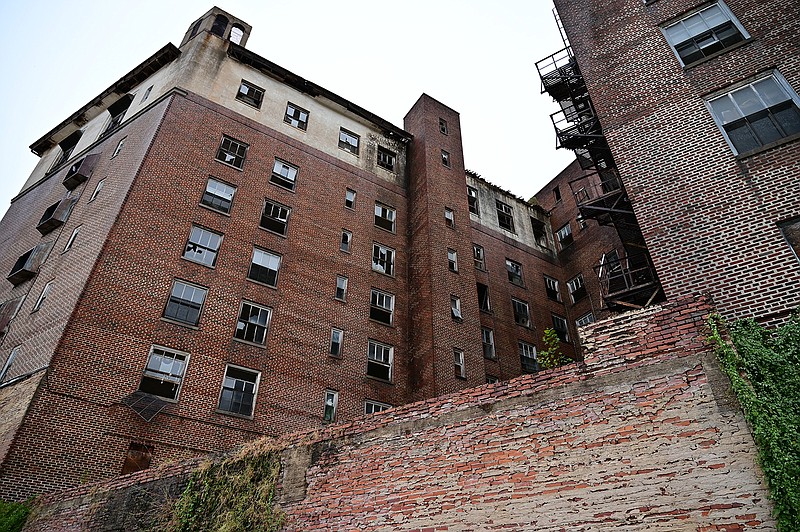TEXARKANA, Texas - As the first visible signs of the Hotel Grim's rehabilitation are appearing, public records shed some light on the toxic materials abatement about to begin at the iconic downtown building.
Local company Texarkana Fence this week began constructing a chain-link security fence around the Grim, taking the first concrete step toward a top-to-bottom renovation that will result in more than 90 apartments plus office/retail space. And Cohen-Esrey Development Group, the developer serving as general contractor for the project, has filed notification with state environmental regulation agencies that asbestos abatement is beginning and will continue into next spring.
Leander, Texas-based Building Abatement Demolition Co. will remove asbestos, lead and mold toxins from the hotel. The abatement stage of the project will involve bringing in portable water and electricity sources, as well as temporary offices. No streets will be closed during the work. BAD Co. has not responded to requests for an interview.
According to a required notification filed with the Texas Department of State Health Services, BAD Co.'s work was scheduled to begin Thursday and is expected to be completed by May 22, 2020.
In the document, the work is described as "Full containment with regulated areas, negative air enclosures, wet methods, PPE, ACM and LBP waste labeling and manifested for proper transport and disposal of pipe, floor tile and mastic, roof mastic, duct mastic and transite."
PPE stands for personal protective equipment, ACM refers to asbestos-containing materials, and LBP means lead-based paint.
Wet methods prevent asbestos particles from being in the air. Negative air enclosures are those, normally made of plastic sheeting, used to control the flow and volume of air within a structure during abatement processes. They are meant to prevent any contaminants from escaping to where they could cause people harm.
Mastic refers to adhesives and sealants used in construction, many of which in the past were mixed with asbestos for fire prevention purposes. Transite originally was a brand name for cement products made with asbestos and has become a general term for other asbestos-containing materials such as insulation and roof tiles.
Removed materials will be disposed of at the Waste Management landfill in New Boston, Texas. A Waste Management spokesperson said any asbestos-containing materials will be sealed in leakproof containers before they are transported and the containers will be immediately buried to prevent any possibility of human contact.
Asbestos is a naturally occurring mineral consisting of long, fibrous crystals that can break down into microscopic fibers. When those fibers are inhaled or ingested, they can become trapped in the digestive tract or respiratory system, according to asbestos.com, the website of the Mesothelioma Center, an advocacy group for those who have asbestos-related disease.
"When asbestos fibers accumulate in human tissue through repeat exposure, they cause inflammation and DNA damage. Over time, this damage causes cellular changes that can lead to cancer and other diseases," according to the site.
"Because of its fiber strength and heat resistance asbestos has been used in a variety of building construction materials for insulation and as a fire retardant. Asbestos has also been used in a wide range of manufactured goods, mostly in building materials (roofing shingles, ceiling and floor tiles, paper products, and asbestos cement products), friction products (automobile clutch, brake, and transmission parts), heat-resistant fabrics, packaging, gaskets, and coatings," according to the Environmental Protection Agency.
The $25 million Hotel Grim rehabilitation project will restore portions of the building, including the grand lobby and the Palm Court Room, and convert the former hotel room floors into modern apartments. On completion expected in late 2020, the property will contain 93 rental apartments in a mix of efficiencies, one- and two-bedroom units.
Named after Texarkana banking, railroad and timber magnate William Rhoads Grim, the hotel opened in 1925. Construction cost was nearly $1 million, and the 250-room hotel was luxuriously appointed in marble and other elegant decor. The hotel served the many train passengers who in the course of their travels spent a night or longer in Texarkana. It closed in 1990.


